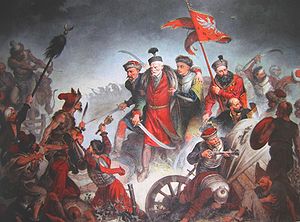Battle of Cecora (1620)
| Battle of Cecora | |||||||
|---|---|---|---|---|---|---|---|
| Part of the Moldavian Magnate Wars and Polish–Ottoman War (1620–1621) |
|||||||
 Death of Hetman Stanislaw Żółkiewski with his confessor, Father Szymon Wybierski, in the Battle of Cecora (1620), by Walery Eljasz-Radzikowski |
|||||||
|
|||||||
| Belligerents | |||||||
|
|
|
||||||
| Commanders and leaders | |||||||
|
|
Gabor Bethlen |
||||||
| Strength | |||||||
| 9,000 Commonwealth troops 600-1000 Moldavian troops |
20,000 Ottoman troops to 60,000 unknown Wallachian troops |
||||||
| Casualties and losses | |||||||
| Unknown | Unknown | ||||||
The Battle of Cecora (also known as the Battle of Ţuţora/Tsetsora Fields) was a battle between the Polish-Lithuanian Commonwealth (aided by rebel Moldavian troops) and Ottoman forces (backed by Nogais), fought from 17 September to 7 October 1620 in Moldavia, near the Prut River.
Because of the failure of Commonwealth diplomatic mission to Constantinople, and violations of the Treaty of Busza by both sides (as Cossacks and Tatars continued their raids across the borders), relations between the Ottomans and the Commonwealth rapidly deteriorated in early 1620. Both sides began preparing for war, as neither was quite ready for it at the time. The Ottomans declared war against Poland in 1620 and planned to attack in the spring of 1621. The Commonwealth Sejm denied most funds the hetmans had asked for. The Senate's secret council finally decided, convinced by the Habsburgs' representative, to contribute the Commonwealth forces in 1620—even though many members of the Sejm thought that Polish-Lithuanian forces were neither sufficient nor fully prepared. Hetman Stanisław Żółkiewski, who was by then over 70 years old (as Commonwealth policy didn't allow for a possibility of forced retirement from government offices such as that of hetman), foresaw the coming confrontation with the Ottoman Empire and decided to meet Ottoman troops on foreign soil, Moldavia being the obvious choice. However, the sultan sent Iskender Pasha to Moldavia to remove Hospodar Gaspar Gratiani, who had allied himself with Poland.
Hetmans Zółkiewski and Koniecpolski led the army to Țuțora (Cecora in Polish sources), a commune in Iaşi county, Romania), to fight the Horde of Khan Temir (Kantymir). The army numbered between 5,000 to 9,000 (2,000 infantry but only about 1600 Cossack cavalry), with many regiments being made up of the private forces of magnates Koreckis, Zasławskis, Kazanowskis, Kalinowskis and . The army entered Moldavia in September. The Moldavian ruler, hospodar Gaspar Graziani, nominally a vassal of the Ottoman Empire, decided to rebel and support the Commonwealth against the Ottomans. Graziani killed the janissaries in Iaşi, imprisoned envoys of Sultan Osman II (who had ordered his removal from power and his transport to Istanbul) and then prepared to flee, but was forced by Żółkiewski to attach his troops to the Polish-Lithuanian camp. However, many of the Moldavian boyars left the camp in order to defend their own estates against pillaging by undisciplined Commonwealth magnates' troops, others decided to wait and see what the outcome appeared to be so they could join the winning side, and others joined the Turks. Consequently, only about 600–1000 rebel Moldavian troops appeared in the Commonwealth camp. Żółkiewski ordered the army to proceed to the fortified camp (standing from previous wars) at Cecora.
...
Wikipedia
